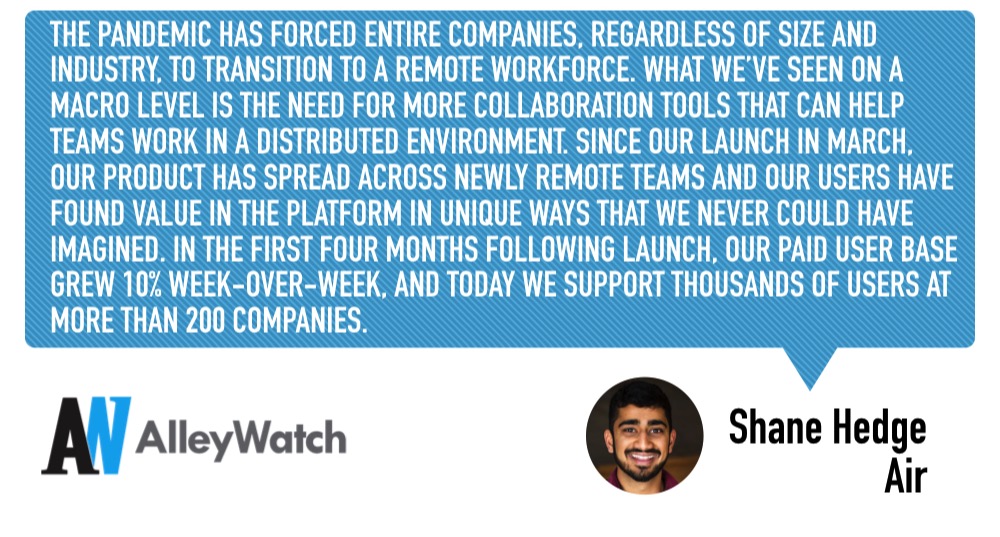While visual storytelling has solidified its place as a crucial marketing tactic, marketing & creative teams have had to rely on a variety of legacy platforms and solutions to discuss, collaborate, and give feedback on visual content. Cloud collaboration tool Air fundamentally changes the way in which teams handle visual work through its native-solution that’s designed specifically for visual collateral. Targeting the 700M+ creatives scattered around the world, Air allows users to better manage assets via smart tags and photo recognition. Traditional cloud storage solutions like Dropbox or GoogleDrive treat visual work like any other file making it arduous to manage. The company, launched earlier this year, has found that approximately 90% of its customers convert over from one of these more traditional solutions.
AlleyWatch caught up with CEO and Cofounder Shane Hegde to learn more about Airs’ impressive traction through the pandemic, the company’s roadmap, and the experience of fundraising over Zoom. Air ha now raised a total of $18M.
Who were your investors and how much did you raise?
We’re excited to announce our $12M Series A led by Tiger Global. Additional institutional partners include Lerer Hippeau, Slack Fund, WndrCo, Red Sea Ventures, and Advancit Capital.
We’re thrilled to also have put together an advisory group of angel investors from leading tech companies and direct-to-consumer brands. This includes Jenny Fleiss (CEO, Rent the Runway), Nic Jammet (CEO, Sweetgreen), Brian Lee (former CEO, Honest Co), Joe Thomas (CEO, Loom), Jack Altman (CEO, Lattice), and several others.
 Tell us about the product or service that Air offers.
Tell us about the product or service that Air offers.
Air is a cloud collaboration tool for creative minds that fundamentally changes the way teams approach visual work. Our product makes collaboration easier, and eliminates the need to move assets to and from the cloud. On Air, teams of all sizes can organize, share, and collaborate seamlessly in a space designed for visual work.
What inspired the start of Air?
My cofounder, Tyler Strand, and I met in college and have been close friends for years. Prior to Air, we were both working at the intersection of media and technology and were similarly frustrated by the creative limitations of cloud storage. In short, content was becoming increasingly important across industries, but teams didn’t have the right tools to work with content effectively. It was clear to both of us that there was an opportunity to solve this technical problem, and support new and increasing important visual workflows. We built Air with the mindset that you should be able to do more with your content than just store it in the cloud.
How is Air different?
Cloud storage was built for storage, not creativity, search, or ease of use. On Air, all of your assets are automatically organized with smart tags and photo recognition, so you can easily search for assets like a search engine. Users can also review and manage their content directly on the cloud in a workspace that’s highly visual and clean. We know how much time is wasted trying to find assets, manage messy email chains, and hunt down feedback — we give that time back to our users every single day.
What market does Air target and how big is it?
We designed Air as a workspace for the 700 million creative minds that deal with visual workflows every day. Most are marketers, brand builders, and creatives, but over time the entire organization, from partnerships to product, find value in tapping into life on Air.
What’s your business model?
Our business is to provide users with product value and automation that can save them time and help them enjoy the creative process. Our product is free to trial and we charge $10 per user per month for our entry plan. Additional features for power users are included in our $30 per user per month pro plan with customized data migrations for folks still using hard drives or local storage systems. On Air, enterprise-grade media infrastructure is now immediately accessible for individual creators and agencies in the matter of seconds.
How has COVID-19 impacted the business?
The pandemic has forced entire companies, regardless of size and industry, to transition to a remote workforce. What we’ve seen on a macro level is the need for more collaboration tools that can help teams work in a distributed environment. Since our launch in March, our product has spread across newly remote teams and our users have found value in the platform in unique ways that we never could have imagined. In the first four months following launch, our paid user base grew 10% week-over-week, and today we support thousands of users at more than 200 companies.
What was the funding process like?
We kicked off the fundraising process in April with just 4 months of runway to raise capital. I won’t lie, it was a really challenging process for the team. It took us +40 days of nonstop work to arrive at a term sheet and more than 100 digital meetings with +50 firms. Resolve is now an integral part of our story and I hope that our journey will help other leaders build confidence in their own.
What are the biggest challenges that you faced while raising capital?
There was no playbook for launching a company during a pandemic or fundraising on Zoom; we structured processes that felt right and made up the rest along the way. I’m someone who loves being in person and spending the extra time getting to know someone. This wasn’t possible, but we back channeled as much as possible to get to know firms and carved our extra time on the weekends to talk about our vision and personal lives. Our team documented everything (dozens of Notion docs), continually improvised, and communicated directly. These three pillars of our process were the only reason we got it done.
What factors about your business led your investors to write the check?
The market and our customers. In today’s content-driven world, businesses continue to rely more on visual storytelling than ever before. Remote work has only accelerated this and the market dynamics were painted clearly for investors. Through the process, our customers were berated with diligence calls, and our NPS come through loud and clear: they loved Air, it was a daily essential tool, and they would recommend it to all of their peers.
In today’s content-driven world, businesses continue to rely more on visual storytelling than ever before. Remote work has only accelerated this and the market dynamics were painted clearly for investors.
What are the milestones you plan to achieve in the next six months?
We have ambitious plans to solidify Air’s position as the collaboration platform for visual work. Over the next several months, we are investing heavily in product development and talent acquisition. Listening to our customers will always be prioritized and you will see us release new pricing tears and product features directly attuned to their feedback. We’re just getting started, and over the next 6 months, our work will constantly reach toward the vision we have for Air.
What advice can you offer companies in New York that do not have a fresh injection of capital in the bank?
Get organized, structure your process, and dictate your timelines. It might be back to back Zooms for a few weeks, but over-index on work that can clarify who you are, what partners you’re looking for, and why. Mechanically this means you’ll talk to more partners, but say no and get to a no quickly with conversations that don’t seem right.
Get organized, structure your process, and dictate your timelines. It might be back to back Zooms for a few weeks, but over-index on work that can clarify who you are, what partners you’re looking for, and why. Mechanically this means you’ll talk to more partners, but say no and get to a no quickly with conversations that don’t seem right.
Where do you see the company going now over the near term?
Our plan is to continue focusing on our customers, our team, and our community. We will improve our product to support all visual workflows in the creative process: listening and iterating on feedback in real-time. Our team will grow, but we will remain focused on personal development. And you have my promise that we will never lose sight of the happenings in the world around us and how we can best support.
What’s your favorite outdoor dining restaurant in NYC?
I told you previously and I’ll say it again: you can’t beat the rooftop at Llama Inn. It’s a magical land filled with Lomo Saltado and Quinoa (yes, quinoa) that is so good it will make you cry pre-pandemic tears.
You are seconds away from signing up for the hottest list in New York Tech! Join the millions and keep up with the stories shaping entrepreneurship. Sign up today






